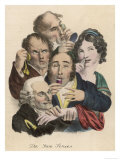|
|
The Senses & Sensory Systems Educational Posters & Charts
for the science classroom, home schoolers, physicians and health professionals offices.
|
science > biology > anatomy > SENSE & SENSORY SYSTEMS < health posters
|
|
The senses are the physiological method of perceiving outside stimuli; depending on method of classification there are between 9 and 21 identified human senses. The five most commonly identified senses, attributed to Aristotle, are sight, hearing, smell, taste, and touch. Others are sense of pain (nociception), balance (equilibrioception), joint motion and acceleration (proprioception & kinesthesia), sense of time, temperature differences (thermoception), and in some a sense of direction (magnetoception).
Also some individuals, such as the artist Wassily Kandinsky, have a “crossing over”, a synesthesia of senses, where a sound elicits the sensation of color, or a color is heard.
The “sense of intuition” is the apparent ability to acquire knowledge independent of any reasoning process, an immediate apprehension. Intuition was one of the four psychological functions described by Swiss psychologist Carl Gustav Jung.
• “I have a fine sense of the ridiculous, but no sense of humor.” ~ Edward Albee
• “Equipped with his five senses, man explores the universe around him and calls the adventure Science.” ~ Edwin Hubble
• “Touch has a memory.” ~ John Keats
• “Vision is the art of seeing things invisible.” ~ Jonathan Swift
• “All our knowledge has its origins in our perceptions.” ~ Leonardo da Vinci
|
|
Overview of Five Senses
One thing all senses share is that when they detect something, they translate it into a common form–the nerve signal, which travels along sensory nerves to the brain. These nerve messages are the body's “language.” Sense organs transform stimuli (such as sound waves, light rays, flavors, odors, or physical contact) into electrical nerve signals, which are instantly flashed to the brain for interpretation and identification.
• Sight • Hearing • Taste • Smell • Touch
|
|
|
|
Hearing
Poster Text: Sound waves consist of vibrations of molecules in the air. When sound waves reach the ear, they are directed towards the eardrum, which begin to vibrate. The vibrations of the eardrum are magnified by the three bones of the middle ear, and then transferred to the fluid of the inner ear.
Within the inner ear, the vibrations stimulate hairlike receptor cells in the cochlea. These cells tranform the vibrations into electrical nerve impulses, which are sent to the brain and interpreted as sound.
Humans can hear sounds that range form 0 to 140 decibels. Ears can detect the direction from which a sound originates to with three degrees. A whisper is 10 dB or less, while a jet engine registers 120 dB or more.
• hearing & ears posters
|
|
|
|
Sight Poster
Sight is our dominant sense. About 70% of the body's sense receptors are packed into the eyes. Every second, these receptors send millions of nerve signals to the brain. Vision is estimated to occupy more than one-third of our total sensory awareness, and is the source of more than half of the information in the brain.
~~~
Light enters the eye through the cornea, and through the pupil.
The retina is made up light-sensitive cells which send electrical signals through the optic nerve to the brain.
As light rays pass through the cornea and the lens, they are bent and focused. The light rays continue through the vitreous humor forming a clear image in the retina at the back of the eye.
In each eye, the retina contains about 125 million cells called rods and about 6 million cells called cones. The rods detect the grightness of light, and are especially effective in dim light. The cones detect the color of light, and allow us to see fine detail.
The image formed in the retina is upside down because of the way the lens inverts light rays. The image is automatically turned right side up in the brain.
• sight & eyes posters
|
|
|
|
Dermatomes Poster
Defines dermatomes and illustrates cutaneous areas of peripheral nerve innervation, development of dermatomes in extremities.
• nervous system posters
|
|
|
|
Taste Poster
not available
|
Taste
While a newborn has taste buds all over the inside of the mouth, adults' taste buds are mainly on the surface of the tongue. An adult has as many as 10,000 taste buds. Taste bud cells last only a week before being renewed by the body.
The sense of taste works in conjunction with the sense of smell to create flavor. The taste of food is a combination of several factors, including the feel of the food in the mouth, its smell, and its appearance.
The temperature of food also influences taste. When food is warm or hot, it releases more chemicals into the air. These trigger our sense of smell, which increased flavor. Heat increases the flavor of sweetness, while cold decreased it. Taste buds also seem to work better at warmer temperatures.
Taste buds on the tongue are located around the base and sides of papillac.
BITTERNESS is tasted at the back of the tongue.
SOURNESS is tasted along the sides of the tongue.
SALTINESS is tasted along the side at the front of the tongue.
SWEETNESS is tasted at the front of the tongue.
• more digestive system posters
|
|
|
Smell Posters
not available |
Smell Poster
On average the human brain can detect between 2000 and 4000 different smells. Someone with a highly developed sense of smell can recognize as many as 10,000 odors. The sense of smell “wears off” more quickly than any other sense. The brain becomes accustomed to the new smell, and usually stops registering it within 30 seconds after is it first detected.
One the roof of each nasal cavity is a thumbnail-size patch of lining called the olfactory epithelium.
The olfactory epithelium consists of millions of olfactory sensory cells. Each of these cells has tiny hairs (cilia) projecting downward into a layer of mucus produced by Bowman's glands.
Odor molecules are dissolved in the mucus, which stimulates receptor sites on the cilia. This generates nerve signals that move upward through the nerve fibers to the olfactory bulb, where they are sorted before being sent to the brain for interpretation.
The sense of smell is strongest at birth, and diminishes as we age.
• respiratory system posters
|
|
|

not available |
Touch Poster
The skin is the body's largest organ. In an adult it weighs anywhere from six to ten pounds and measures as much as twenty square feet. Inside the dermis there are millions of microscopic receptors that tell us if something is hot or cold, heavy or light, rough or smooth. The dermis is really where the sense of touch takes place.
The skin contains a variety of nerve endings that detect touch, pressure, cold , heat, or pain. The nerve endings convert sensations into electrical impulses that are then sent to the brain.
When the skin is damaged, cells release chemicals. These activate nerve endings that detect pain.
The first touch receptors appear in the fetus by ten weeks. Neural connections are made in the third trimester.
• Skin & Touch posters
|
|
previous page | top
|
|
I have searched the web for visual, text, and manipulative curriculum support materials - teaching posters, art prints, maps, charts, calendars, books and educational toys featuring famous people, places and events - to help teachers optimize their valuable time and budget.
Browsing the subject areas at NetPosterWorks.com is a learning experience where educators can plan context rich environments while comparing prices, special discounts, framing options and shipping from educational resources.
Thank you for starting your search for inspirational, motivational, and educational posters and learning materials at NetPosterWorks.com. If you need help please contact us.
|
|
|












